Urine Bile Salts and Bile Acid Metabolism
Urine Bile Salts
What sample is needed for Urine Bile Salts?
- This is done in the urine.
- This test can be done on a random sample after the meal.
What are the indications for urine bile salts?
- Bile salts are detected in the urine to diagnose various conditions of liver diseases (Jaundice).
- To diagnose obstructive jaundice.
What are the precautions for urine bile salts?
- The postprandial sample is preferred because it allows a more sensitive distinction between normal and abnormal results than the fasting sample.
- Eating will stimulate secretion.
How will you define bile salts in the urine?
- Bile acids and bile salts are used as synonyms.
- Bile acids, when conjugated, are called bile salts.
- Bile acids are present in the bile as conjugates of taurine and glycine.
- Bile is slightly alkaline and contains enough sodium (Na+) and potassium (K+).
- Most of these bile acids and conjugates exist as salts, also called bile salts.
- Bile acids are conjugated with taurine or glycine in the liver. Sodium or potassium conjugates of these bile acids are called bile salt.
- Primary bile acids are synthesized in the liver.
- Secondary bile acids are produced in the colon by bacterial action.
- Bile salts are formed when a base neutralizes an acid.
How will you discuss the Metabolism of bile acids?
- The liver assists intestinal digestion by secreting 700 to 1200 mL of bile acids daily.
- Bile is an alkaline, bitter taste, yellowish-green fluid.
- Gallbladder bile is more concentrated than hepatic bile.
What is the Difference between hepatic and gallbladder bile?
| Constituents | Hepatic bile | Gall bladder bile |
|
|
|
|
|
|
|
|
|
|
|
|
|
|
|
|
|
|
|
|
|
|
|
|
What are the primary bile acids?
- Cholic and chenodexycholic acid constitute 60% to 95% of the bile.
What are the secondary bile acids?
- These are lithocholic acid and deoxycholic acid
- This process occurs through the intestine’s microflora. The bacterial 7-α-hydroxylase enzyme gives rise to secondary bile acids, deoxycholic acids, and lithocholic acids.
- In the liver, these secondary bile acids are conjugated with taurine and glycine, join the primary acid as the bile components, and transform into bile salts.
What is the composition of the bile acids?
| Type of bile acid | % of the bile acid in bile |
| Primary bile acid |
|
|
|
|
|
| Secondary bile acid | |
|
|
|
|
What are the factors controlling bile acid secretion?
- The carrier-mediated active transport of bile acids into the bile canaliculi generates osmotic water flow and is the primary factor regulating bile formation and secretion.
- The influence of bile acid secretion on biliary lipids excretion:
- In large part, this is due to the ability of bile acids to solubilize cholesterol and phospholipids in an aqueous medium in mixed micelles.
- Hepatic bile contains 5% to 15% solids, and bile acids are major components.
- Bile acids have a major role in regulating the bile flow.
- The hormone secretin increases bile flow without any increase in the bile flow output.
Write briefly about Lithocholic acid?
- It is a secondary bile acid, and its properties are:
- It is water-insoluble.
- It precipitates in the colon.
- It is toxic to liver cells and RBCs.
- This may lead to cholestasis.
- When a small dose of lithocholic acid is injected, it may cause the following:
- Fever.
- Headache.
- Nausea.
- Malaise.
- Local inflammatory reaction.
- Its sulfated form is excreted in the feces.
- Instead of all these toxic injuries, it is found normally in the bile and the blood, so there must be some protective mechanism to protect from its toxic damage.
What are the contents of Bile salt?
- Conjugated bile acids.
- Cholesterol.
- Bilirubin.
- Electrolytes.
- Water
- Sodium glycocholate.
- Sodium taurocholate.
- Potassium and calcium bile salts are also common.
What are the Bile salt functions?
- The gall bladder contracts after each meal and sends 500 to 600 bile into the duodenum.
- Bile Facilitates fat absorption.
- Bile helps in intestinal emulsification.
- Most bile salt is actively absorbed in the terminal ileum and returned to the liver through portal circulation for resecretion.
- The recycling of bile salts is termed enterohepatic circulation.
- Bile salts are made in the liver from cholesterol, and these help in fat absorption. They make them more soluble.
What is the significance of bile salts and their excretion?
- The biliary obstruction prevents the bile salts from entering the duodenum and leads to their accumulation in the blood.
- In liver cells damaged by bile salts, these bile salts, which are not removed by the enterohepatic circulation, enter the systemic circulation.
- Itching is caused by the increased concentration of bile salts in the blood circulation.
- In cirrhosis, acute or chronic hepatitis, or drug reactions leading to cholestasis, the concentration of the bile salts in the blood increases.
What is the mechanism of increased bile salts in the body?
- Bile salts appear in the urine when the biliary tract is blocked, increasing the blood’s bile acids.
- Serum bile salts may rise even without the biliary obstruction if liver cell damage usually removes reabsorbed bile salts from the portal blood.
- Salts not removed from the enterohepatic cycle enter the enterohepatic circulation and give a sensitive hepatocellular dysfunction index.
- In many cases of jaundice, itching is caused by the bile salts in blood circulation.
- Bile salts are positive in urine in other liver diseases.
- Cholestasis, retention of bile, and bile salts lead to Itching (Pruritus).
- The biliary obstruction prevents the bile salts from entering the duodenum and leads to their accumulation in the blood.
- Serum bile salts may increase liver diseases.
- The level of bile salts correlates with itching.
What are the causes of cholestatic itching?
- Primary biliary cirrhosis.
- Primary sclerosing cholangitis.
- Intrahepatic cholestasis of pregnancy.
- Hereditary cholestatic syndrome.
What are the complications of deficiency of bile salts?
- In the bile, bile salt deficiency allows cholesterol to precipitate as gallstones.
- Bile salts in the intestine emulsify the fat for absorption.
What is the mechanism of excretion of the bile pigment and bile salts?
- The bile pigments, including bilirubin, urobilinogen, and bile acids (bile salts), are excreted through the kidneys and pass into the feces.
What is the normal urine bile salts?
- Typically, bile salts are negative in the urine.
How will you detect bile salts in the urine?
- Bile salts can be quantified by:
- Spectrophotometry.
- Chromatography.
- Radioimmunoassay.
- Bile salts reduce the surface tension of liquids.
- The Scotch physician described this test (1885 to 1932).
How will you perform the HAY test?
- Sulfur powder is sprinkled over the surface of urine, and it sinks if bile salts are present.
- When bile salts are absent, sulfur will remain (float) on the surface.
- It can run in the control water where the sulfur granules (float) remain over the surface.
What are the possibilities of a positive bile salt test?
- Obstructive jaundice.
- Liver diseases with the appearance of jaundice.
How will you summarize the bile acids and bile salt?
- Bile acids are water-soluble bile components derived from the cholesterol metabolism in the hepatocytes (liver cells).
- Two primary bile acids are formed: cholic acid and chenodeoxycholic acid.
- These primary bile acids conjugate with glycine and taurine, then excreted from the liver cells into bile.
- Bile salts are the components of bile, and bile is greenish-yellow fluid stored in the gallbladder.
- Conjugated bile acids are stored in the gall bladder along with bile and released into the duodenum.
- These will absorb fats and fat-soluble material.
- Cholic acid is reabsorbed only in the terminal ileum.
- Small amounts of the circulating bile acids are excreted through the kidneys, and a small amount reaches the colon.
- Two cycles of bile acid metabolism occur 2 hours after the meal.
Questions and answers:
Question 1: What are the primary bile acids?
Question 2: What are secondary bile acids?

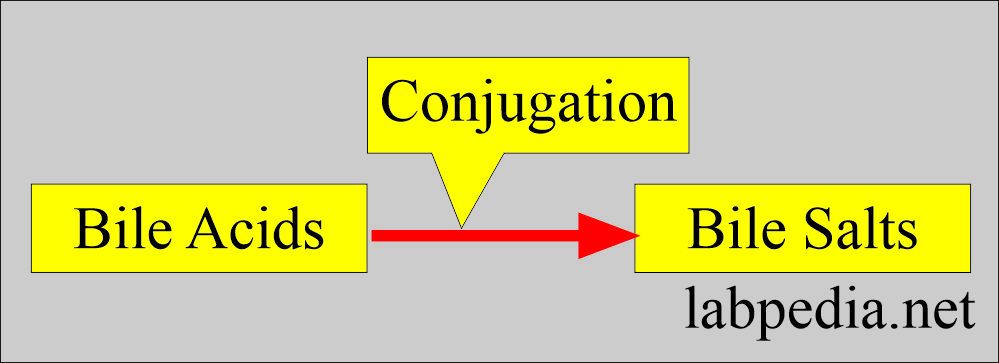
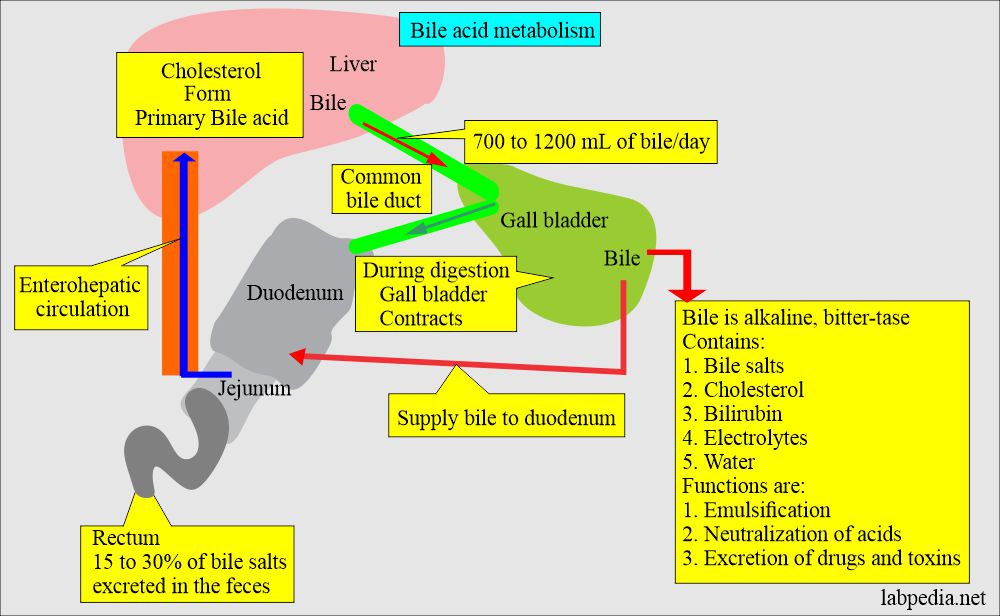

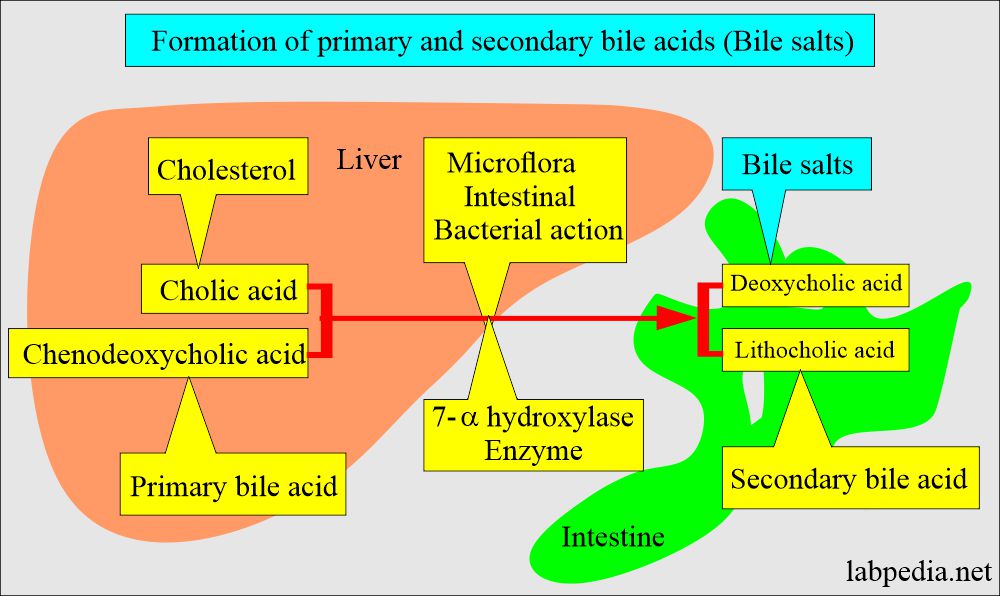
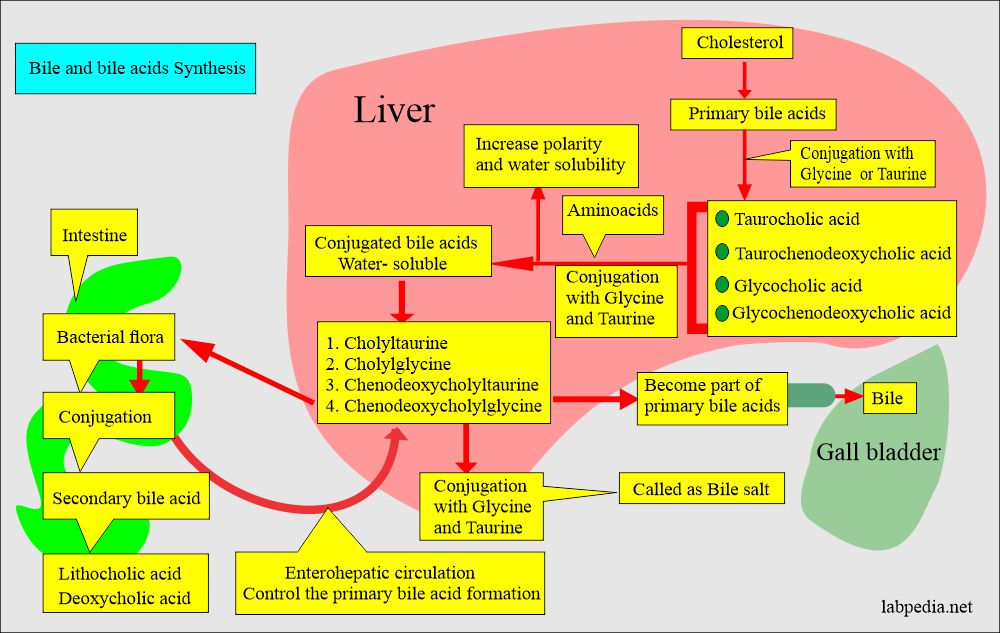
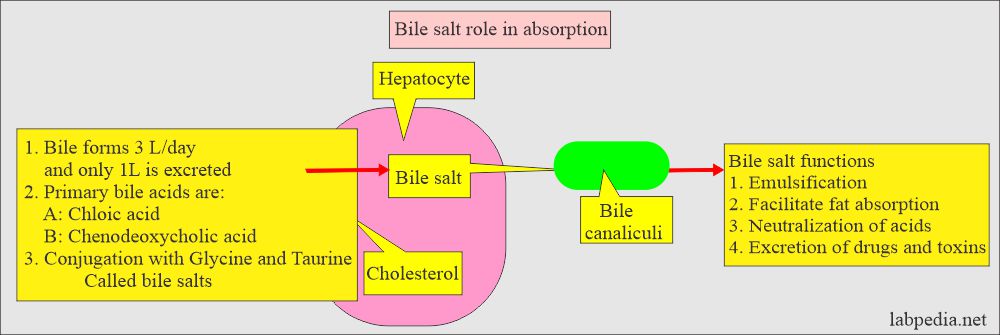
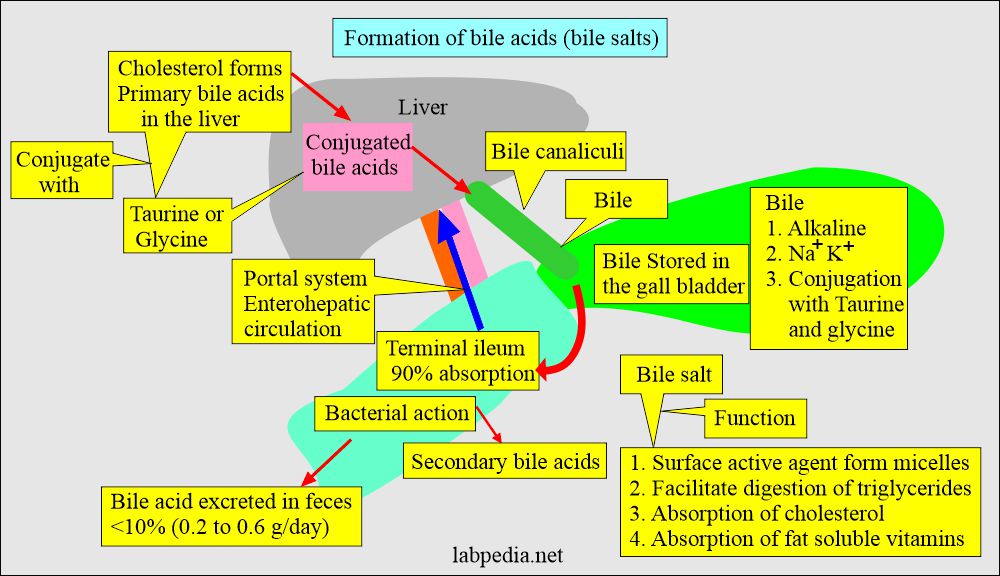
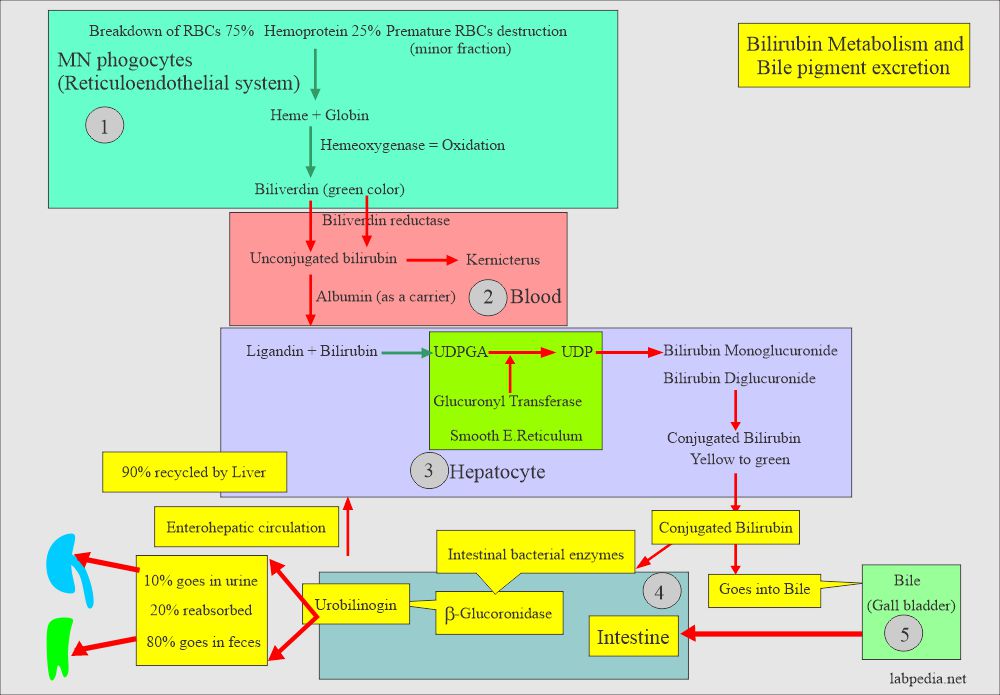
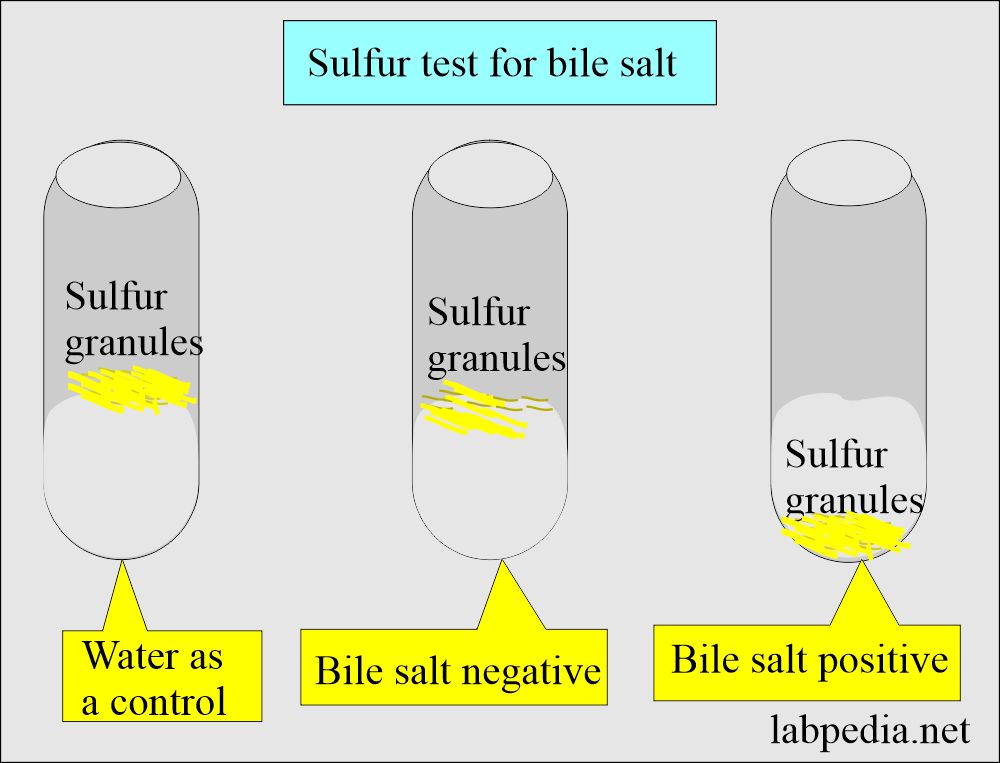
I need some updates guidlines if possible about hepatology
Please can you elaborate on the specific field which you want in hepatology? I have already covered some of the topics related to liver.
నాకు మూత్రం లో బైల్ సాల్ట్స్ positive అని వచ్చింది… ఇవి తగ్గాలంటే, నేను చేయాలి
Thanks for the question. You have most like liver disease and possibility is obstructive jaundice. Please consult some physicians and have an ultrasound of the abdomen to find the cause of obstruction.
ప్రశ్నకు ధన్యవాదాలు. మీకు కాలేయ వ్యాధి వంటిది చాలా ఉంది మరియు అవకాశం అబ్స్ట్రక్టివ్ కామెర్లు. దయచేసి కొంతమంది వైద్యులను సంప్రదించి, ఉదరం యొక్క అల్ట్రాసౌండ్ను కలిగి ఉండండి.
Please see my comments.
All signs are in me from nausea, fever, vomiting etc.
Please consult a physician if you have all the above signs.
What does it mean if bile salt is indicated as absent in the urine test.
Normally bile salts are absent in the urine.
What could be the reason for urine leakage after urinating. I dont have irritation while nurinating but after urination, I amnsuffering from urine leakage…..
Hi Dr. I have this complaint of urine leaking after urinating, it remains for sometime and then gets normalised. Again once ai urinate then I face the same problem. I did took Urine routine test, it says everything is normal like Bile salt is absent. My doctor there is no urinary infection. I feel tired but doctor its just viral infection tiredness… can u suggest a treatment for this
Please consult a urologist. You have not mentioned your age. Sometimes in the late age group, you may have this issue.
IN WHICH CONDITION BILESALT IS PRESENT IN URINE AND BILE PIGMENT IS ABSENT?
Bile pigments are part of bile salt.
https://labpedia.net/bile-salt-in-the-urine-and-bile-acid-metabolism/
Please also see this link.
https://labpedia.net/urine-for-bile-pigments-bilirubin-urobilinogen-and-bile-salts/
Recently I am testing cue ,, in that result bile salt is absent means
Bile salt absent is normal or ubnormal
Bile salts Negative in urine is normal.
Bile salt absent in urine is normal>
Dear Dr. Riaz,
My daughter has mild cholecystitis with high urinary bile acids on urinalysis and recently bilirubin 1+ of bilirubin crystals. All serum hepatic enzymes are within the normal range, no jaundice and serum bilirubin is normal. Also she has lipiduria and urine PH 7 despite respiratory acidosis.
She developed recently mild kidney disfunction with high phosphate excretion.
On blood exams: hypophosphatemia, hypo cholesterolesterimia, normal creatinine and urea, normal albumin, normal calcium and all electrolytes except low mildly sodium and mildly elevated magnesium.
Her kidney function is progressively deteriorating since in recent several months.
Diagnosis was still not made by many professionals, as her symptoms are unspecific and not constant.
She has very strange response to any administrated iv fluids with precipitation of the electrolytes in the renal tubules if in the solution present calcium or magnesium.
Do you have any suggestions on what to look for?
Your daughter has complicated history. I think physician can better diagnose the reason. I can just say some genetic deficiency..